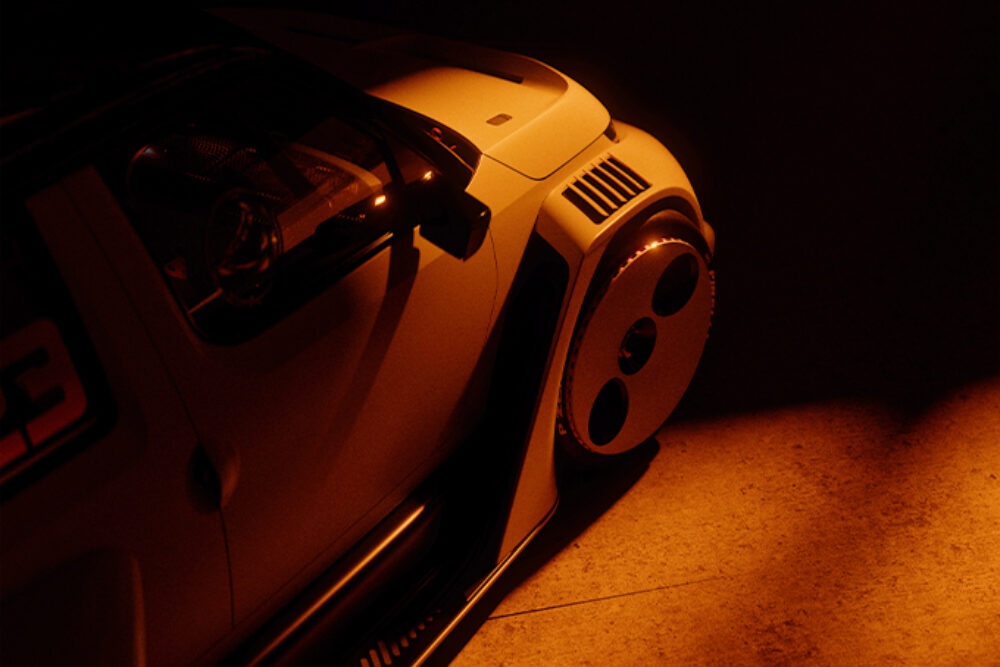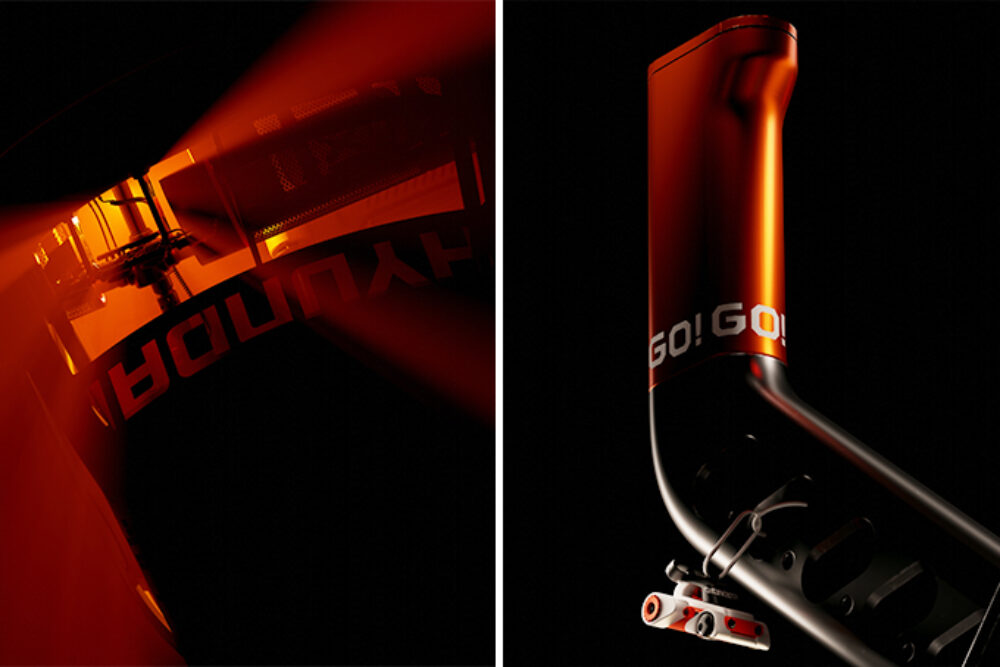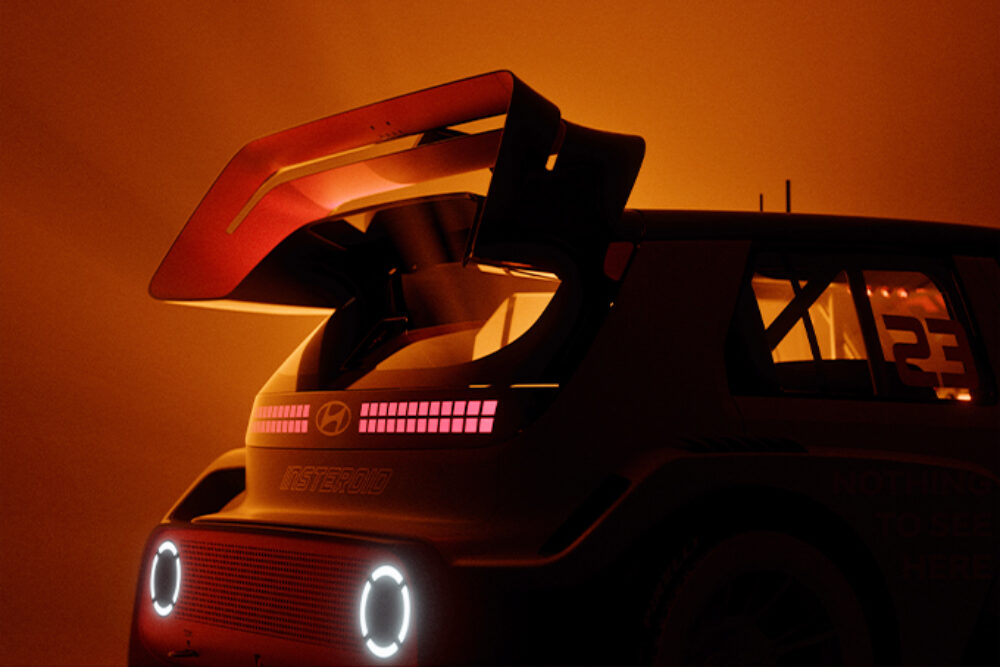Remember playing those racing video games where cars looked impossibly aggressive, with fender flares wide enough to need their own zip code and rear wings that could double as picnic tables? Hyundai just decided to bring that energy into the real world with their new Insteroid concept, and we’re honestly here for it. Taking their humble little Inster EV (that tiny electric crossover they sell in Europe and Asia) and turning it into something that looks like it escaped from a Group B rally stage, Hyundai has created what might be the most entertaining concept car we’ve seen this year.
If the name sounds like something that requires a prescription, you’re not wrong – Insteroid is a mashup of “Inster” and “steroid,” which perfectly captures what Hyundai has done here. They’ve taken their mild-mannered city car and injected it with whatever digital performance enhancers they could find in the virtual world. The result is a hot hatch on steroids that seems to exist purely to make us smile, and in an era of increasingly serious EVs, that’s refreshing.

Digital Dreams, Physical Reality
While most concept cars these days are busy trying to look serious and production-ready, the Insteroid feels like a designer’s fever dream that somehow made it past management. Hyundai describes it as a “thrilling ‘glitch’ in the automotive matrix,” which is marketing-speak for “we had fun with this one.”
The teaser images show a car that’s almost comically aggressive compared to the cute little Inster it’s based on. Massive boxed wheel arches reminiscent of 1980s Audi Quattro rally cars dominate the profile, while the rear sports a wing that looks like it was stolen from a Formula 1 car. There are functional-looking vents everywhere, a roof scoop (on an EV!), and what appears to be a full roll cage visible through the windows.
Adding to the gaming aesthetic are Hyundai’s signature pixel LED lights at the rear, giving the whole package a distinctly digital vibe. The 21-inch wheels (up from the standard Inster’s modest 17-inchers) feature circular spoke designs that evoke the mechanical cogs of classic arcade games.


From Econobox to Digital Hotbox
For reference, the standard Inster that this concept is based on is about as exciting as you’d expect for a more traditional Hyundai. It’s a practical little urban EV with either 95 or 113 horsepower, depending on the battery pack, and takes a leisurely 11 seconds to reach 60 mph. Top speed? A blistering 93 mph. It’s the automotive equivalent of sensible shoes.
The Insteroid, by contrast, looks like it wants to devour rally stages for breakfast. While Hyundai hasn’t revealed if the concept actually has an upgraded powertrain or is just a styling exercise, the visual promise of performance is unmistakable. The company says that “every element – from the control buttons to the instrument cluster, the rear spoiler to the brakes – reflects Insteroid’s character,” suggesting that the transformation might be more than skin deep.


When Cars Escape the Console
What makes the Insteroid particularly interesting is how it blurs the line between virtual and reality. For decades, we’ve seen real cars digitized for video games, but now we’re seeing the reverse – video game aesthetics influencing physical car design. It’s as if someone at Hyundai looked at the wildly modified cars in games like Forza Horizon or Gran Turismo and said, “Why can’t we make that?”
Even if it never makes it to production (and let’s be honest, it probably won’t), the Insteroid represents an interesting experiment in automotive design. By embracing the exaggerated, consequence-free styling of video games, Hyundai has created something that feels fun and rebellious in a way that few modern concept cars do.
What Could Have Been
In an alternate universe, the Insteroid could have been Hyundai’s answer to the hot hatch segment – an electric successor to the wild homologation specials of rallying’s golden era. Looking at its proportions, it’s easy to imagine an all-wheel-drive setup with significantly more power than the standard Inster, perhaps something closer to what Hyundai has done with the larger Ioniq 5 N.
While the company hasn’t revealed any performance specs (or if the concept even has a functioning drivetrain), the Insteroid could potentially show the direction for future performance EVs from the brand. Hyundai has already proven they understand how to make electric cars fun with the Ioniq 5 N – shrinking that formula into something Inster-sized could be genuinely exciting.
Spec Sheet
Model: Hyundai Insteroid Concept
Based On: Hyundai Inster EV
Powertrain: Unknown (standard Inster offers 95 or 113 HP electric motors)
Wheels: 21-inch custom design (up from standard 17-inch)
Special Features: Massive rear wing, boxed wheel arches, roof scoop, pixel LED lighting, apparent roll cage
Design Inspiration: Racing video games, Group B rally cars
Reveal Date: Early April 2025
Production Plans: None announced (concept only)
Pricing & Availability
Since the Insteroid is strictly a concept car, there’s no price tag attached. Hyundai plans to fully reveal the car in early April 2025, but has made it clear this is a “one-of-a-kind concept” with no immediate production plans. Given the current state of automotive regulations and safety standards, it’s hard to imagine something this wild making it to showrooms without significant taming.
Hyundai Insteroid EV Concept Car
The Hyundai Insteroid concept transforms the humble Inster EV into a video-game-inspired rally monster, complete with massive flares, an enormous wing, and pixelated lighting – proving that even in the EV era, automotive design can still embrace fun and fantasy.








